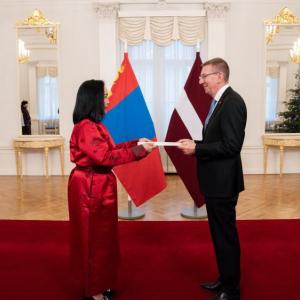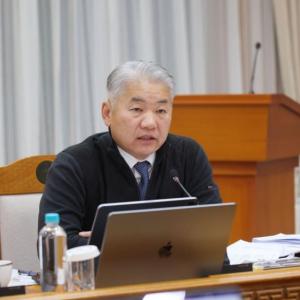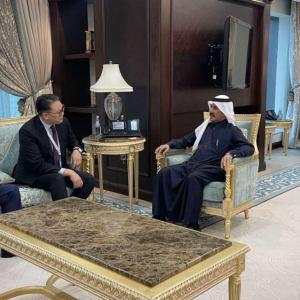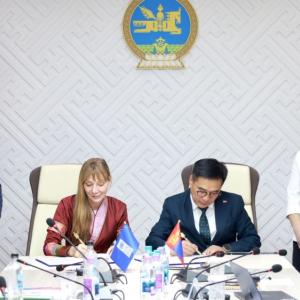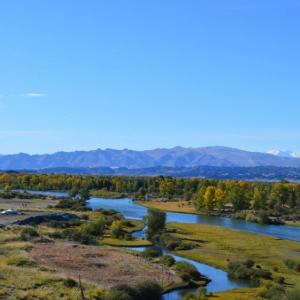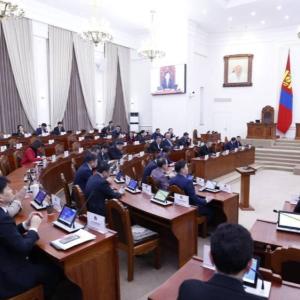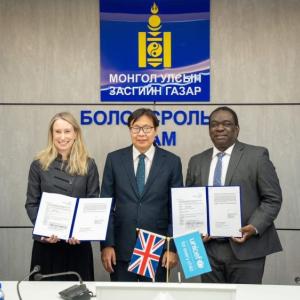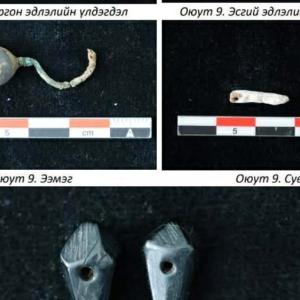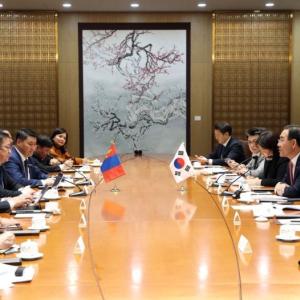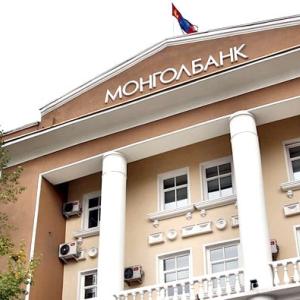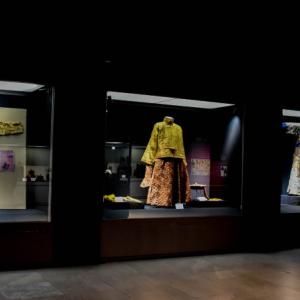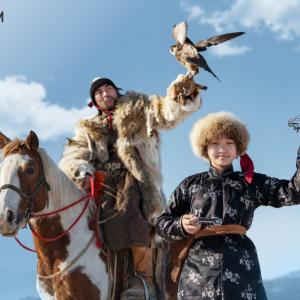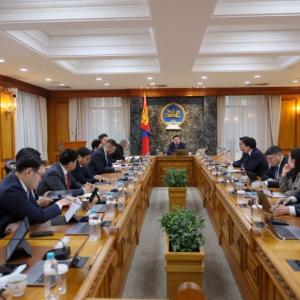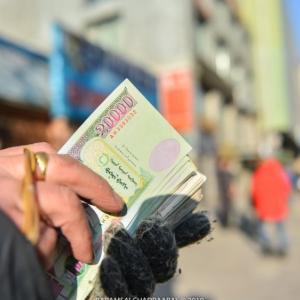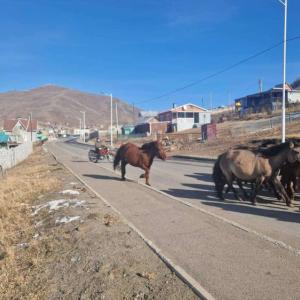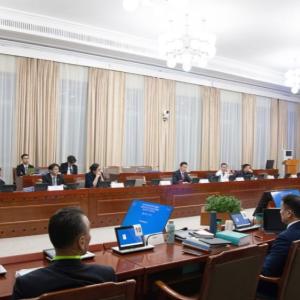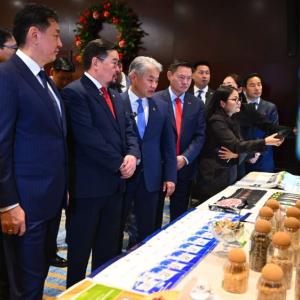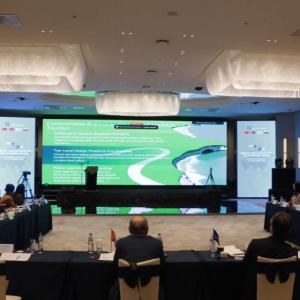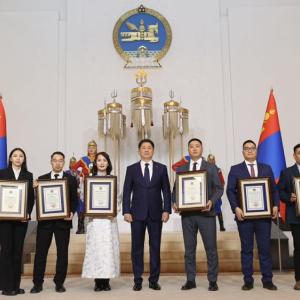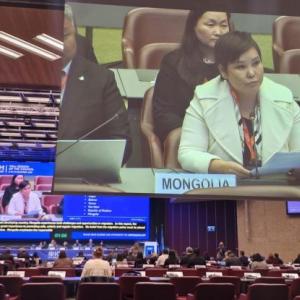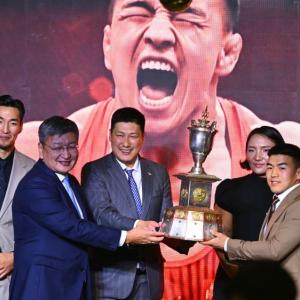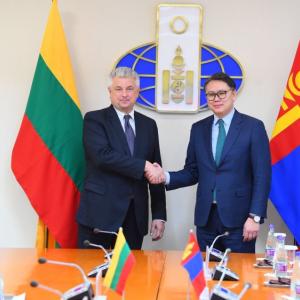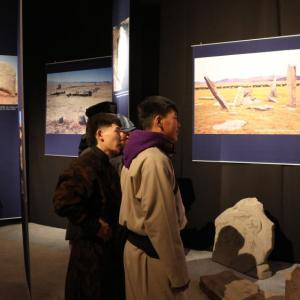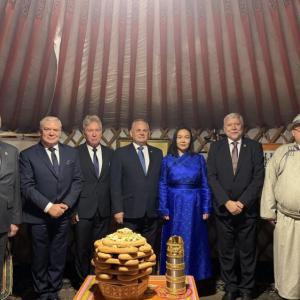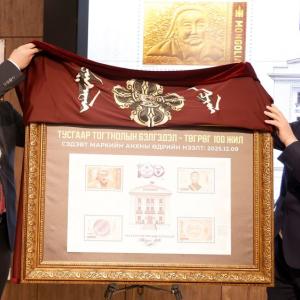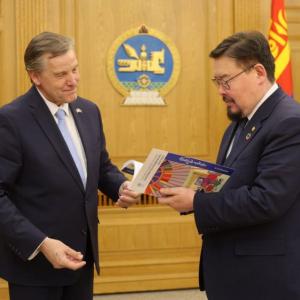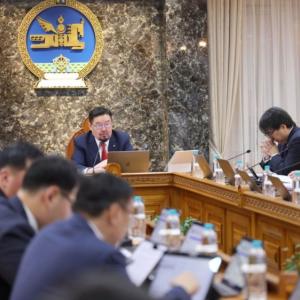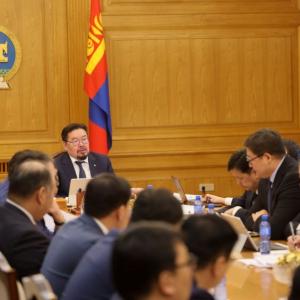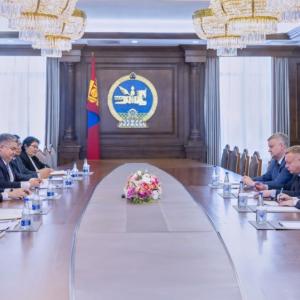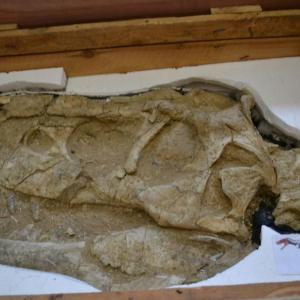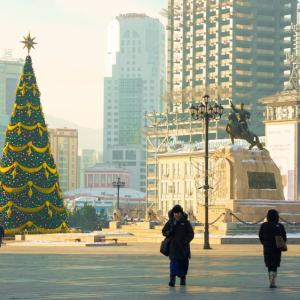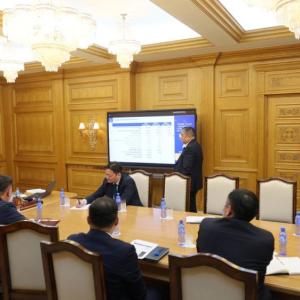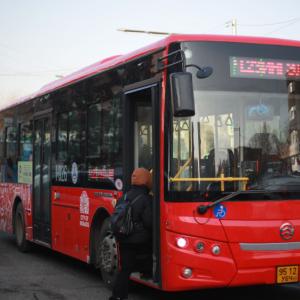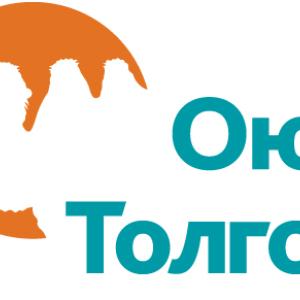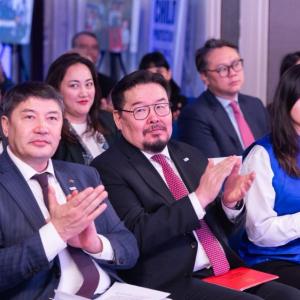Prehistory and antiquity
About Mongolia | HistoryTraces of the early inhabitants

Archaeological finds have confirmed that almost the entire territory of Mongolia was settled in prehistoric times. From the 1920s, archaeological excavations around Mongolia unearthed many interesting and important sites, a large number of them prehistoric. Of particular interest are settlements with graves and semi-subterranean dwellings near the town of Choibalsan, Dornod Aimag, the eastern province of Mongolia, and finds in the area around Bayanzag, Omnogobi Aimag, the southern province. These were discovered in the 1920s by the third Central Asiatic Expedition led by American Roy Chapman Andrews. Excavations of these settlements and graves showed that the bodies were interred in a seated position in narrow pits, with bone knives and pearl beads.
Human traces from the middle and later Paleolithic periods have also been found in many regions of Mongolia, particularly in the Moiltyn valley, on the river Orkhon near Kharkhorin, the ancient capital, as well as in the valleys of the Selenge, Tuul and Kherlen rivers, deep in the Gobi and on the steppes of the Mongol Altai. A wonderful monument of primitive culture–cave paintings of Khoit Tsenkher, in Khovd Aimag, 1,200km west of Ulaanbaatar, bear witness to the high level of intellectual development of people in Mongolia of that period. A large number of bronze implements, decorations and household utensils found in these places are on display at the Natural History Museum, evidence that this country was a cradle of Asian civilization. About the same time that iron weapons began to appear, in the third century BC, inhabitants of Mongolia began to form tribal alliances and to threaten China. The archaeological evidence indicates that the area that is now Mongolia was populated as early as 500,000 years ago.
First nomadic tribes and states
Although people have inhabited Mongolia since the Stone Age, Mongolia only became politically important after iron weapons entered the area in the 3rd century BC. In general, Mongolia at this point had a similar history to the rest of the nomadic steppe that lies between Siberia Northern Russia to the North, China, and, the Middle East and Central Asia to the South. These steppes usually were inhabited by tribes of nomads, sometimes united in confederations of varying sizes.
Hunnu Period
The establishment of the Hunnu in Mongolia in the 3rd century BC landmarks the beginning of the statehood on the territory of Mongolia. The founder of the Hunnu Kingdom was Tumen. He was succeeded by his son Modun Shanyu whose Unified Kingdom stretched from Lake Baikal in the north to the Great Wall of China in the south and from the Erchis river in the west to the Greater Khyangan mountains in the east. During the Hunnu period, there was significant development in the culture of Mongolian tribes – arts, music, astronomy and astrology – and twelve month lunar calendar was introduced. The state had significant diplomatic, cultural and trade relations with neighboring states.
However, after a fierce internal struggle, in 53-55 BC the mighty empire of the nomads broke up into Southern and Northern Huns. Some of them drifted away from their native territory to the Caspian steppes, while the others moved further west to the Danube-Carpathian valleys, where they formed a sizeable nomadic state under the leadership of Attila Khaan, most successful invader of the Roman Empire. The graveyards, human settlements and rock pictures of the Hunnu State were discovered across the vast Euroasian territories, the most of which were found in the territory of the presentday Mongolia. Over 600 or 95 percent of graveyards of the Hunnu aristocrats were found on the territory of Mongolia and judging from their culture and traditions the Hunnu Empire was considered to be the first State of the Mongolians. The country celebrates 2225 th anniversary of the Hunnu Empire nationwide in 2011.
The Era of Chinggis Khaan
 In 55 BC the Jujan Khanate was defeated by the Altai Turks, and for almost five centuries they were subjugated by tbe Turkic people -the Turks, Uigur and Kyrgyz. During this time, native Mongols lived in the eastern and north-eastern regions of what is now Mongolia, forming small separate khanates. The largest tribes at that time were the Khamag (Whole) Mongols, the Khereid, Merged, Naiman and Tatars. The basic wealth of these Mongolian herder tribes comprised sheep, goats, horses and cattle. There were a few camels, bred chiefly by the Naiman. The horse was the daily means of locomotion and a faithful friend in battle, on the march and in hunting. With feudal division and internecine strife, the khuree (ring-shaped disposition of families) was widely used as a defence against surprise attack. Vestiges of the clan system, customs and religious beliefs (shamanism) were retained even after the feudal mode of production became predominant.
In 55 BC the Jujan Khanate was defeated by the Altai Turks, and for almost five centuries they were subjugated by tbe Turkic people -the Turks, Uigur and Kyrgyz. During this time, native Mongols lived in the eastern and north-eastern regions of what is now Mongolia, forming small separate khanates. The largest tribes at that time were the Khamag (Whole) Mongols, the Khereid, Merged, Naiman and Tatars. The basic wealth of these Mongolian herder tribes comprised sheep, goats, horses and cattle. There were a few camels, bred chiefly by the Naiman. The horse was the daily means of locomotion and a faithful friend in battle, on the march and in hunting. With feudal division and internecine strife, the khuree (ring-shaped disposition of families) was widely used as a defence against surprise attack. Vestiges of the clan system, customs and religious beliefs (shamanism) were retained even after the feudal mode of production became predominant.
At the beginning of the eleventh century, Khamag Mongols emerged as the leading clan of a loose confederation in central Mongolia. The Khamag Mongol Ulus (state) was ruled by Khabul Khan; one of his most influential successors was his grandson, Yesuhkei-Baatar, who ruled over the largest of the Khamag Mongol tribes, the TaichuudTemujin, the future Chinggis Khaan, was born into Yesukhei-Baatar’s family in Deluun Boldog, on the upper reaches of the Onon river, in 1162. In 1170 Yesukhei-Baatar was poisoned by Tatars, and soon after his death his Ulus disintegrated.
The Great Mongolian State
Historians continue to study the establishment of this mighty empire of Mongols in both positive and negative terms but there are still many issues to which there is neither an answer nor reasonable justification. For example, the Mongol Empire with only a half-million population succeeded in conquering during the 13th - 14th centuries more than 40 states of the world with a total population exceeding 100 million, i.e., outnumbering the Mongols by two hundred times. So far, nobody can explain with certainty how and why this could have happened. Morris Rossabi writes “...Mobility and surprise characterized the military expeditions led by Chinggis Khaan and his commanders, and the horse was crucial for such tactics and strategy. Horses could, without exaggeration, be referred to as the intercontinental ballistic missiles of the thirteenth century…” World History, Volume I, Fourth Edition, p 181.
The difficult process of establishing the Mongol state is described in the famous Mongolian manuscript called The Secret History of the Mongols. In 1206, at a Great Khurildai (convention) of Mongol princes on the banks of the Onon river, Temujin was proclaimed supreme ruler of the unified Mongol state and had conferred on him the title of Chinggis Khaan (whom foreigners call Genghis Khan). Chinggis Khaan was an extraordinarily gifted person of high intellect and intuition, an outstanding statesman and political figure of his time, a military genius surpassing all his predecessors and one of the world’s greatest commanders. The principles and rules given by him to the princes began to spread, becoming the customs and statesmanship heritage of the whole Mongolian nation.
He attached great importance to law and traditions, and when he ascended to the throne of a united Mongolian state, undertook a number of steps to strengthen the power of the state. He issued a code of laws called Ikh Zasag and establishing a system of 95 myangats (units of 1,000) to simplify the organization and administration of military and civil affairs; some historians describe this as the optimal political system.
The 95 myangats were divided into three areas; the central one was under Chinggis Khaan’s own rule, while the right and left principalities were governed by Mukhulai and Boorchi. With these initial steps towards a system of government of a vast empire, strengthening and centralizing state power, Chinggis Khaan ensured the security of the northern and western boundaries. Chinggis Khaan’ s policy towards foreign countries was called the “Altan Argamj” (The Golden Tether), The policy was aimed at maintaining peace and developing friendly relations with neighboring countries.
However, the state of relationships with neighboring countries at the time made it difficult to practice these policies. The Mongols’ neighbors in the east, south and west continued to devise hostile policies resorting to force, especially the Tanguds and the Chin dynasty, who were displeased with the emergence of a centralized Mongolian state and the unification of Mongol tribes. In the autumn of 1209, Chinggis conquered the Tangud. In 1211, accompanied by his sons Zuchi, Tsagaadai, Ugedei and Tului and brother Khasar, he launched a campaign against the Chin dynasty and in 1215, conquered its capital, Beijing. In 1216, the Khar Kidans were subdued.
The Mongol Empire now included several states of central Asia and the eastern Turks, reaching as far as the borders of the Khorezm state. In 1218, Chinggis Khan dispatched a caravan with ambassadors on a diplomatic and commercial mission to the capital of the Khorezm state, Urgench. At the frontier town of Otrar, the caravan was pillaged and the ambassadors murdered. Later, three Mongolian emissaries, sent to Khorezm to investigate the incident, were subjected to unprecedented humiliation. The royal court saw these acts as blatant insults and a blow to the Mongol state’s desire to develop normal trade and political relations. This enraged the Mongol ruling class and forced military confrontation.
Invading Khorezm in 1221 after capturing Bukhara and Samarkand, the Mongol troops took Urgench. Chinggis Khaan’s youngest son Tului then led Mongol troops into Afghanistan and northwestern India. Troops under the command of Zev and Subeedei, great Mongol commanders, invaded Georgia and Azerbaijan in 1221. The Mongol leaders then thought they had accomplished their mission. Before returning to Mongolia, however, they decided to rest their troops and to gain more information about the lands to the north and the west. They camped near the mouth of the Dnieper River, and their spies soon were scattered throughout eastern and central Europe. Meanwhile, a mixed Russian-Cuman army of 80,000 under the leadership of Mstislav, prince of Kiev, marched against the Mongol encampment. Zeb and Subeedei sought peace; however, when their envoys were murdered, they attacked and routed Mstislav’s force on the banks of the Kalka River in 1223.

After six years of war the Mongol State reached as far west as the Black Sea. Chinggis Khaan issued edicts ensuring the right to practice other religions and preventing religious intolerance and hostilities. He instructed his soldiers and officers to avoid destroying occupied countries’ churches and temples, and carried out policies with respect to religious persons, exempting them from taxation and military service. His exceptionally flexible mounted army and the cadres of Chinese and Muslim siege-warfare experts who facilitated his conquest of cities comprised one of the most formidable instruments of warfare that the world had ever seen.
In the autumn of 1225, after six years of campaigning, Chinggis Khaan returned home. He then received news that the rulers of the Tangud state of Si-Sya had entered into a secret alliance with the Chin dynasty and were undertaking hostile policies towards the Mongols. So, in 1226, he launched another major campaign against the Tangud and, in 1227, its capital city Irgai was captured. In the same year Chinggis Khaan was wounded while out hunting and on August 25, 1227, the founder of the Mongol Empire, expander of its borders throughout central Asia and Middle Asia, died. After continuous campaigning against the neighboring hostile states, the Mongols occupied in the 13th-15th century, a huge part of Eurasia, having established several large empires - The Golden Horde, the State of Ilkhans in Persia, the State of Great Mogols in India, the Yuan Empire in Chine etc..
Thus, during his 20-year rule the Chinggis Khaan initiated the first major direct contact between East and West, in what later become known as “Pax Mongolica” Then all major world trade and political relations went through the capital of Mongolia of that time, Khara Khorum and the flow of ambassadors from France, sons of Georgian and Armenian sovereigns, Russian princes, and Chinese officials was unceasing.
The establishment of the Great Mongolian State put an end to the strife of Mongolian tribes and ensured favorable conditions for the formation of the Mongolian nation. Opportunities were provided for further development of the nomadic civilization, including the Mongolian language, culture, and customs. In 1204, Chinggis Khaan introduced a written script for the Mongolian language. He attached much importance to its knowledge and employed many scholars, sages and officials as his advisors. Tatatunga, an official from the Naiman tribe and Yelyui Chutsai, a Kidan scholar both served at Chinggis Khaan’ s court.
The Mongol Empire under Chinggis Khaan’s Successors
In accordance with die Great Khaan’s last will, the Mongol Empire was divided between his four sons. The eldest, Zuchi, received the lands west of the Irtysh River. His second son, Tsagaadai, inherited the territory between the rivers Amudarya and Syrdarya. The third son, Ugudei, was given possession of western Mongolia and Tarbagatai. As was traditional, the youngest son Tului inherited his father’s ancestral land. In 1229 the Great Hurildai elected Ugudei official successor to Chinggis Khaan. His name is associated with a number of innovations in the development of the Mongol Empire.

He set up a regular horse-relay post service (morin ortoo), which lasted until the mid-20th century, for fast communication throughout the empire and to ensure safe travel for dignitaries. In 1230 Ugudei sent troops to Persia; these, in 1231-1239, also invaded the Caucasus. Guided by Chinggis Khaan’s will, Ugudei concluded a tactical agreement with the Song dynasty of southern China on joint action against the Chin, and in 1231 he led a campaign to crush the Chin Empire and complete the conquest of northern China. Ugudei khan died in 1241. In fact, for more than four years the Imperial Court was ruled by Durgene khatan, the widow of Ugudei. At last, in 1246, the Great Khurildai elected Ugudei’s son Guyug as the new Khaan. His coronation ceremony was attended by more than 4000 foreign guests overall. But he died just after two years during the marsh to the west.
The fourth khaan of the Mongol Empire, Munkh (1251-1259), undertook two military campaigns. One, led by his brother Khubilai (founder of the Mongolian Yuan state), was to complete the conquest of China. The other, invading Iran, was led by his brother, Hulege. In 1258 Hulege took Baghdad and overthrew the Abbasid dynasty.
These wars resulted in a dispersal of the Mongolian tribes and a considerable reduction in the size of the homeland population. However, the wars also precipitated the unification of various Asian and European tribes, and drew east and west closer than ever before Chinggis Khaan’s descendants went on to stretch the Mongol Empire across most of Eurasia, conquering all of modern-day China and Mongolia, as well as substantial portions of modern Russia, southern Asia, Eastern Europe and the Middle East. In the 13th -15th centuries they established several large feudal empires – The Golden Horde, the State of Ilkhans in Persia, the State of Great Mongols in India and the Yuan Empire in China.
After the defeat of the Mongolian Yuan state by the Chinese Min in 1367, the Mongolian khaans returned from Beijing to their native land, and Mongolia ceased to be the centre of world trade and culture. Between 1388 and 1400, various khaans succeeded each other as rulers of what is now Mongolia. The eastern and western Mongol struggle intensified in the early 15th century as a result of action by Ming China.
The strife resulted in the emergence in 1452 of the Mongol Oirad state. Some sources describe this as the period of small khaganates. In the second half of the 15th century, the Mongol state was divided into east and west and then subdivided into six principalities. The eastern comprised the tribes of Khalkh, Ordos, Uriankhai, Tumd, and Yunsheby. The western Mongolian Oirads comprised the tribes of Durvud, Khoshuud, Torguud and Tsoros.
The period from the 17th to the early 20th century was the bleakest in Mongolian history, with 275 years of Manchu domination. The Manchurians cut off the Mongolian state from the world for this time, and Mongolians lived as if inside an inverted copper pot.
Renaissance of the Mongolian State

At the beginning of the 20th century, external and internal pressures in Khalkh Mongolia led to the downfall of Manchu tyranny. Resistance to the Manchu Qing Empire embraced all of society. In 1900, there was an armed revolt of soldiers in Uliastai. In Ikh Khuree there were a number of uprisings by lamas against the Manchu and China. The Mongolian resistance movement, led by the Bogd Khan, was nationwide.
On December 1, 1911, what was then called Outer Mongolia proclaimed its independence from Manchu domination and its intention to unite all Mongolian-speaking people. On December 29, 1911, Bogd Javzundamba was crowned head of religion and state, with the title Elevated By All, and the state was named Mongolia. The Bogd Khaan established the Domestic Affairs, Foreign Affairs, War, Finance and Justice Ministries. Thus, at the beginning of the 20th century, the national liberation movement restored the old statehood and independence of Mongolia.
However, further progress was frustrated because of the expansionist policies of Tsarist Russia and of China. In 1919 the Chinese government Broke the 1915 Russian, Chinese, Mongolian tripartite treaty and invaded Mongolia and took Niislel Khuree.

1921 the Khalkh Mongols, the dominant ethnic group in modern
Mongolia (khalkh means shield or protection), led by S.
Danzan, D. Bodoo an
This led to an upsurge of the national liberation movement, and in 1921 the Khalkh Mongols, the dominant ethnic group in modern Mongolia (khalkh means shield or protection), led by S. Danzan, D. Bodoo and D. Sukhbaatar, liberated Mongolia. July 11, 1921 was nominated as day to celebrate the creation of an independent Mongolian state. Since then, this day of the victory of the people’s revolution has been celebrated as a national holiday. Between 1921 and 1924 Mongolia was a republican monarchy, but in 1924, with the death of the Bogd Khaan, it became a Soviet-style republic with a one-party system that lasted until 1990. 1939-1945 was difficult war period for Mongolians.
In May 1939, the Japanese army invaded eastern Mongolia. Between May and September 1939, there was large-scale ground and aerial fighting along the Khalkhyn Gol river in northeastern part of the country .The Soviet and Mongolian joint army won the battle at the end of August, 1939. On August 14, 1945 in the Sino-Soviet Treaty of Friendship and Alliance, China agreed to recognize the independence of Mongolia within its “existing boundary,” provided that a plebiscite confirmed the Mongolian people’s desire for independence. Mongolia obliged, and in an October 20 referendum, 100 percent of the electorate voted for independence from China.
Two key figures dominated politics from the mid 1930s to 1984, as leaders of the ruling Mongolian People’s Revolutionary Party (MPRP). Khorloogiin Choibalsan (1895-1952) developed a Soviet-style economy and destroyed theocratic power by intense political and religious purges, ruling until his death in 1952.
The rule of Yumjaagiin Tsedenbal (1916-1991) was marked by increasingly close integration with the USSR while following a program of urbanization and rapid industrialization of the old livestock economy. The country, which at the end of the 19th century was viewed by western historians and scholars as almost extinct as a nation, achieved considerable economic progress in areas like animal husbandry, agriculture and industry. The population tripled by the end of the 20th century to over 2 million, and annual population growth rose to 3.5 per cent.
Just over 90 years ago, most people were illiterate, but by 1960 almost every adult in the Mongolian People’s Republic was able to read and write. This was in sharp contrast to that the only education was provided by monasteries for those destined to become monks. UNESCO awarded a special prize to recognize the striking educational progress made during the 1960s, when all school age children went to school and learned to read and write. The 20th century witnessed progress in the arts, sport and science. As well as significant achievements in the 1960s in the economy and social spheres, the country also entered the international arena.
In 1962, Mongolia joined the UN, which the government trumpeted as an official world acknowledgment of independence and sovereignty. From the 1960s, Mongolia extended its foreign relations, establishing diplomatic relations with over 150 countries (up to 2010) in Europe, North America, Africa, Asia and Australia.
Democracy development

The winds of eastern European change in the late 1980s also reached Mongolia. The democratic movement strengthened, becoming more organized and unified gaining national support. In the movement towards democracy, political parties such as the New Progress Union, the Social Democratic Movement, the Mongolian Green Party, the Mongolian National Progress Party, the Mongolian Free Labor Party and the Mongolian Social Democratic Party were formed.

As a result of a peaceful democratic revolution, the country’s political system was changed. In July 1990, the first free general election took place and Mongolia finally became a parliamentary republic, with a president and a multi-party system. Mongolia re-affirmed its democracy with successive elections to the State Great Khural (parliament) in 1996, 2000, 2004, 2008 and 2012, presidential elections in 1996, 2001, 2006, 2009, 2013.
The Conception for the Development of Mongolia (CDM), adopted in May 1996 by the State Great Khural, identified the major national objectives for the next 15 to 25 years. This said that Mongolia aimed to become an industrial nation with a self-sustaining economy, a political system based on democratic values, and high levels of cultural and spiritual development. Thus, Mongolia applied the model of the world’s developed countries with democratic legislation in compliance with its specific features and national traditions. Having built up an independent, multi-pillared and open foreign policy, the country is gaining more and more friends, partners and advancing its position regionally and internationally.

As the first Asian nation to witness a victory for its fledgling democracy, Mongolia marked the 25th anniversary of its Democratic Revolution in 2014. Mongolia chaired the Community of Democracies for 2011-2013 in high recognition of its distinguished achievement that established democracy in Mongolia by peaceful means. Mongolians are proud of their country for adopting a democratic Constitution, freedom in society, politics, and economy; thus building brand new individual values for all Mongolians.
 Ulaanbaatar
Ulaanbaatar







